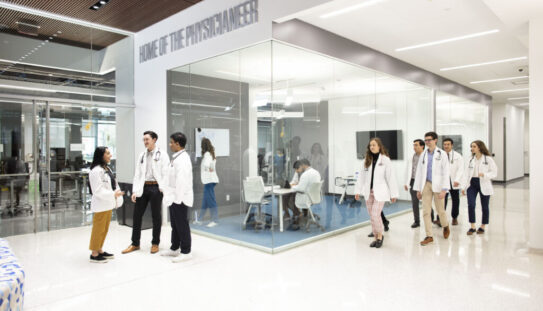
As students are applying to colleges and undergraduate degree programs, the School of Engineering Medicine is preparing for their futures as Physicianeers. The E2ENMED Early Assurance Program is a unique program offered to incoming freshmen or second-year, currently enrolled students pursuing an undergraduate degree in the College of Engineering at Texas A&M University in College Station, Texas.
E2ENMED is a highly competitive early-assurance program that incites students to change the future of medicine and train to become the next generation of physician engineers. From the
start of the application process to the end of their undergraduate career, students are jumping at the chance to become more than a doctor, and more than an engineer—to become a Physicianeer. The E2ENMED program offers students an early opportunity to change health care, forever.
The program offers two options for admission: the first option is for incoming Texas A&M freshmen engineering students, and the second option is for current Texas A&M engineering sophomores. Both options recruit highly qualified individuals that are intent on establishing solutions for the greatest challenges in health care through the process of translating novel medical technologies into real-world applications in the nation’s first fully integrated engineering and medical education curriculum. Being competitive and intriguing, the EnMed program invests its resources into applicants throughout their undergraduate career.
Identifying prospective Physicianeers early advances the objectives of the Engineering Medicine program by starting with young, passionate individuals, eager to leave a mark on health care. The ambitious incoming freshmen are selected from a pool of National Merit Scholars, both semi-finalists and finalists, and/or the College Board of Hispanic Scholars, African American, Native American, and Rural Recognition. After incoming freshman apply to the College of Engineering, they are encouraged to complete a secondary application for consideration to the E2ENMED program. For those accepted, this is a great opportunity to develop the early skills and knowledge to succeed in the graduate and professional Engineering Medicine program.
Second-year students who are already enrolled in an undergraduate engineering degree program, and who have completed a minimum 24-credit hours at Texas A&M University, are also welcome to apply to the E2ENMED Early Assurance Program. Engineering students are recruited for their outstanding performance after their first year as an undergraduate student.
The Engineering Medicine program is complex, ambitious, intriguing, and focused on changing medicine and how it is administered. Both current students and prospective students show promise in the medical field, and by converging medicine and engineering together, Physicianeers will leave lasting impacts in health care. The School of Engineering Medicine embraces its students who have shown promising futures in engineering and medicine and looks forward to welcoming the first class of E2ENMED students in May 2024.
For more information about the E2ENMED Early Assurance program and the application process, please visit enmed.tamu.edu/e2enmed.

